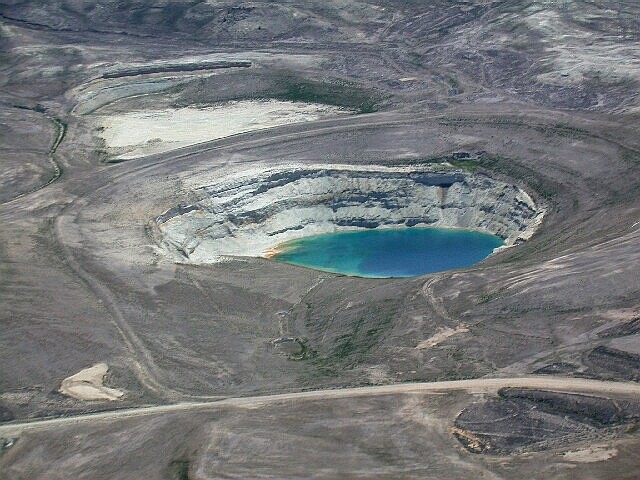
—————————
By Camille Erickson
Casper Star-Tribune
Via- Wyoming News Exchange
CASPER — In a move cheered by Wyoming’s uranium industry, Gov. Mark Gordon endorsed an agreement between the U.S. Environmental Protection Agency and Nuclear Regulatory Commission on Thursday to clarify federal and state regulation of in situ uranium production and cleanup.
The memorandum of understanding essentially outlines what each agency is — and is not — responsible for under the Atomic Energy Act when it comes to overseeing the restoration and maintenance of uranium mine sites.
During a news conference Thursday afternoon alongside EPA Administrator Andrew Wheeler at the Wyoming state Capitol, Gordon called the uranium industry “absolutely essential to Wyoming.”
He lauded Thursday’s action, saying it extended regulatory relief to producers of the commodity at a time when the sector is struggling.
“Finally, this country is starting to recognize how important it is that we have domestic supplies of our most important minerals,” he said. “Uranium, for example, powers our nation.”
Sen. John Barrasso, who chairs the Senate Committee on Environment and Public Works, applauded the recent move.
“This agreement is a major win for uranium production in Wyoming,” Barrasso said in a statement. “The Trump administration is limiting unnecessary regulations and making it easier for American companies to do business. Nuclear power is clean and reliable. It provides carbon-free energy and creates good paying jobs. This agreement will help preserve Wyoming’s uranium industry.”
The Wyoming Mining Association also commended the decision.
“This is something that has been in the works for several years and we’re pleased it has come to this point,” executive director Travis Deti said. “We are hopeful the MOU will streamline the regulatory process for uranium recovery, saving time and resources, which will help in getting the industry back on its feet.”
But environmental groups worry about the long-term effects uranium mining can have on scarce groundwater resources throughout the West, especially with the Trump administration declaring it will not pursue heftier regulations around cleanup of in situ mining sites.
They point to ongoing contamination issues at uranium mine sites across the country and the dangers of the hazardous byproduct to drinking water.
“For decades the uranium mining industry has gotten a free pass to pollute, and now the Trump administration wants to just give up any pretense of protecting scarce water resources across the Mountain West,” Geoff Fettus, a senior attorney at the Natural Resources Defense Council, told the Star-Tribune. “EPA has the legal authority — and the duty — to ensure that the uranium industry restores aquifers after it’s done mining. It appears EPA is more focused on protecting a polluting industry than it is on protecting people and our precious water supplies.”
The organization accused the agency of “relinquishing” its authority to protect the nation’s aquifers from pollution.
Wyoming is one of the epicenters of uranium production in the U.S. And uranium mines here use in situ mining, a specific extraction process that recovers the minerals using a chemical solution. The method keeps the orebody in the ground and minimizes surface disturbance.
But many conservation advocates also said the process puts precious groundwater sources across the arid West at risk of radioactive contamination. Several community groups fear weakening the rules regulating uranium mining on public lands and sacred sites threatens the natural environment and human health, too.
Meanwhile, public officials in Wyoming and uranium producers vehemently maintain the strength of the industry’s safety standards and reclamation commitments.
According to Wheeler, the memorandum of understanding will not shift Wyoming’s role in regulating uranium facilities, a job now led by the state’s Department of Environmental Quality.
“It will not change or require any changes in safeguards that you put into place here in Wyoming for uranium mining,” Wheeler told the Star-Tribune. “So there shouldn’t be any change at all. The main point of the MOU is (eliminating) the duplication between the EPA’s and the Nuclear Regulatory Commission’s efforts at the federal level, to make sure that we’re not layering on top of what all the states are already doing.”
The roots of the memorandum of understanding signed Thursday stretch back several years. The state of Wyoming and federal environmental regulators have long jousted over which agencies should be tasked with regulating the country’s uranium mining activity and how much regulation there should be.
During the Obama administration in 2015, the EPA proposed a groundwater monitoring rule to strengthen health and environmental protections. Under the proposed rule, companies would have had to conduct 30 years of groundwater monitoring after using the in situ process, among other restoration requirements.
The agency opened up a public comment period on a revised rule just before former President Barack Obama left office.
But in short order, the Trump administration announced it would not pursue the rule on Jan. 4, 2017.
Uranium producers considered the new standards burdensome and unnecessary; conservation groups saw them as fundamental safeguards for surrounding communities and their water resources. It would have required companies to test aquifers and characterize the water quality before mining and monitor groundwater at the site for 30 years, among other restoration obligations.
For years, Barrasso called for the withdrawal of the rule, considering it “not technically feasible and unreasonably burdensome” for Wyoming’s uranium producers. In a 2017 letter sent to the EPA, Barrasso outlined his opposition to the proposed rule, asserting the federal environmental agency was overstepping its authority.
The Nuclear Regulatory Commission licenses and oversees uranium recovery facilities using standards established by the EPA. After mounting pressure, the agency, under the Trump administration, withdrew the proposed rule on Oct. 19, 2018.
The memorandum of understanding signed on Thursday finalizes the rule’s withdrawal and signals the Trump administration’s intent to not introduce new cleanup mandates for in situ uranium mining.
Wyoming leads the country in uranium production. But the industry has been decimated by a record-low appetite for U.S. uranium. Uranium production nationwide has nose-dived to an over 70-year low as nuclear power companies turn to cheaper international markets.
In April, the U.S. Department of Energy asked for $150 million in fiscal year 2021 to build a uranium reserve fund and boost domestic demand for the mineral.
Wyoming officials and energy groups have pressed Trump to institute new trade policies, like quotas, to intensify domestic demand of uranium.
Right now, most utility companies import cheaper uranium from countries, especially Kazakhstan, displacing demand for U.S. production of the commodity.
In last year’s third quarter, only about 32,211 pounds of uranium concentrate were produced at four mines in Wyoming. That’s a 94% decline since the same quarter in 2016, according to the Energy Information Administration.
Last year, Trump established a nuclear fuels working group to drum up recommendations that could strengthen the country’s nuclear fuel cycle, which includes uranium mining. Trump ultimately declined to introduce quotas, but the group still recommended the Energy Department establish a reserve fund next fiscal year.






